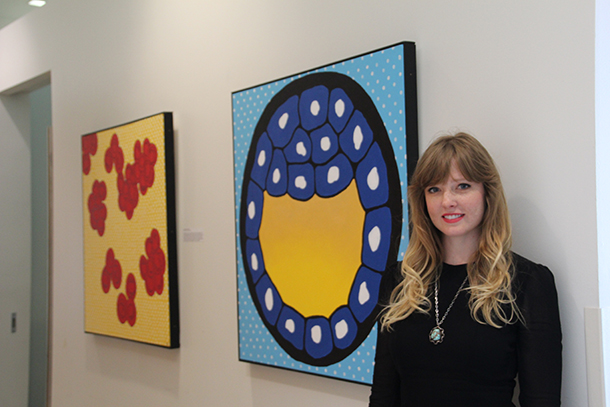“As an artist and scientist, I cannot help but imagine stem cells as ‘superheroes’ fighting against ‘villains’ of disease,” said Kella Vangsness, who graduated May 12 with a master’s degree in stem cell biology and regenerative medicine from the Keck School of Medicine of USC.
Vangsness’ vivid imagination takes form in her series of six paintings titled “Stem Cells: The Heroes of Disease.” Funded by a grant from USC’s Bridge Art and Science Alliance, the large-format paintings, produced with acrylic and a graffiti marker called “krink,” draw inspiration from the original Wonder Woman comics, the pop art of Roy Lichtenstein, and scientific microscopy and textbook illustrations.
Vangsness donated these paintings to the Eli and Edythe Broad CIRM Center for Regenerative Medicine and Stem Cell Research at USC, where they currently adorn the second floor. One of the paintings, “The Astrocyte,” also appeared in a neuroscience-themed art show in the Hoyt Gallery on the USC Health Sciences Campus in Spring 2018, and the full series will go on temporary loan to the new art gallery at the USC Michelson Center for Convergent Bioscience on the USC University Park Campus in Summer 2018.
“Even in the face of challenges,” Vangsness said, “stem cells hold the promise of treating multiple diseases, be it via their regenerative capabilities or with the insight they provide into mechanistic aspects of biological systems and molecular pathways.”
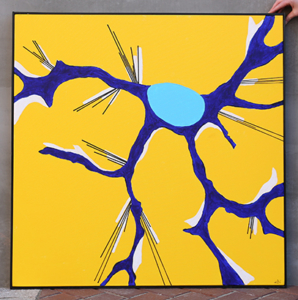
The Astrocyte
The Astrocyte
Acrylic and Krink on canvas, 2017
During development, neural stem cells differentiate into many different types of cells, including the astrocytes that maintain the optimal environment for neurons to transmit signals. Neural stem cells have the potential to be used in cell replacement therapy, drug delivery and disease modeling.
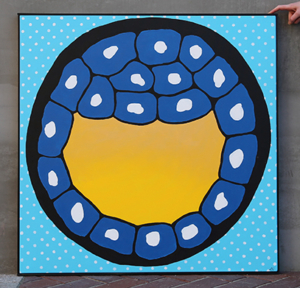
The Blastocoel
The Blastocoel
Acrylic and Krink on canvas, 2017
Human embryonic stem (ES) cells are derived from the inner cell mass of the blastocyst on day five of embryonic development. Human ES cells are pluripotent, meaning they can differentiate into a wide range of cell types with many uses in regenerative medicine.
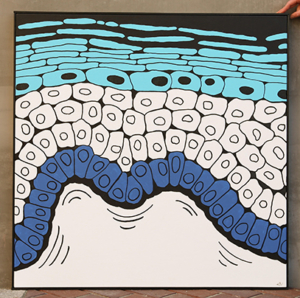
The Skin
The Skin
Acrylic and Krink on canvas, 2018
Skin stem cells are the multipotent adult stem cells that self-renew and differentiate into the layers of the skin. The skin renews throughout life, as well as during injury and repair. Current studies are exploring how these stem cells can heal wounds, treat skin disorders and more.
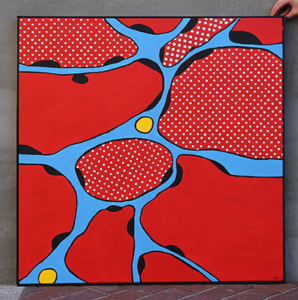
Satellite Cells
Satellite Cells
Acrylic and Krink on canvas, 2018
Satellite cells are the stem cells of skeletal muscle, which shows a remarkable ability to repair post injury. Satellite cells are not as applicable in regenerative medicine, due to the difficulty of isolating them outside of the body.

Hematopoietic Stem Cells
Hematopoietic Stem Cells
Acrylic and Krink on canvas, 2017
Hematopoietic stem cells (HSC) produce and replenish all blood and immune cell types. HSCs are first generated during embryonic development, and then colonize the bone marrow where they reside in adults. HSC therapy, more commonly known as bone marrow transplantation, is the standard treatment for numerous conditions such as multiple myeloma, non-Hodgkin’s lymphoma, Hodgkin’s lymphoma and sickle cell anemia.
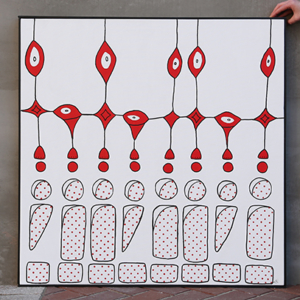
Retinal Cells
Retinal Cells
Acrylic and Krink on canvas, 2018
The retina contains photoreceptor cells, called rods and cones, that react to light and convert it into electrical signals to send to the brain. The retinal pigment epithelium (RPE) layer is essential for maintaining the health of the light sensitive photoreceptors. The RPE cells are lost in macular degeneration, causing the death of photoreceptors and loss of central vision. Current stem cell-based clinical trials, including one based at USC, look to use stem cells to slow the progression of this common cause of blindness.
The Artistic Process
Each painting began as a pen-and-ink drawing that was only three inches across. Vangsness then used a projector to enlarge this tiny design, and trace its outlines in Krink onto a canvas three feet across. Finally, she brought each painting to colorful life using acrylics and pop art-inspired brushwork.
— Cristy Lytal, with captions by Kella Vangsness


